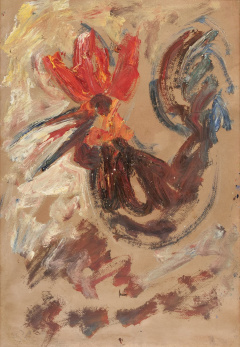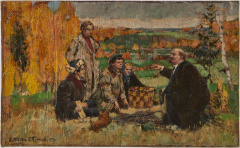Artist of the week: Andrea Mantegna
- one of the most famous masterpieces by famous Italian Renaissance master Andrea Mantegna.
name and work of Mantegna's not as well known to Russian audiences, such as Sandro Botticelli and Leonardo da Vinci, but modern art historians have called it one of the "geniuses, it has happened a sudden and radical change" in European art ( J. Argan ), and Vasari in the XVI century, wrote that "there is always someone who would be able to recognize, appreciate and reward someone's or talent as talent was recognized by Andrea Mantegna "(It is not known who it was referring to a biographer, but as we shall see below, this man was not one).
| Andrea Mantegna Self-Portrait (brought into the temple. Fragment). 1465-1466 Tempera on canvas. 67 × 86 Berlin art gallery Source: commons.wikimedia.org | 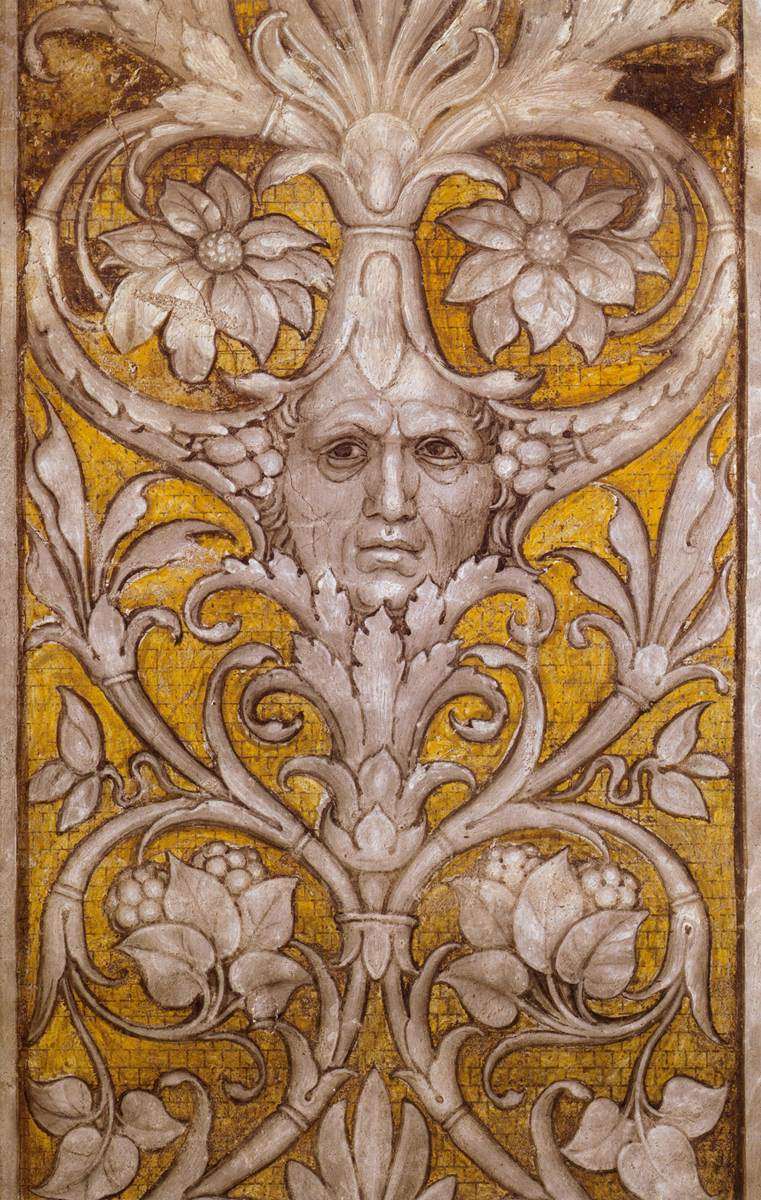 Andrea Mantegna Self-Portrait. 1465-1474 fragment of fresco Camera degli Spozi Palazzo Ducale, Mantua, Italy Source: wga.hu |
Andrea Mantegna (Andrea Mantegna) was born in 1431 in a family of carpenters Biagio, in the town of Isola di Cartura, between Padua and Vicenza. In the decade of 1441, Andrea was given an apprentice painter Francesco Skvarchone Padua. Who succeeded in their early thirties (ie, very mature at the time) aged craft tailor and embroiderer on the profession of the painter, Skvarchone became famous educator, founded the Academy of Fine Arts and the Museum of Padua with her. Well-known collector of antiquities, from travels in Italy and Greece, he brought the casts of antique sculptures, and they, apparently, were also benefits for students who have Skvarchone had over a hundred people.
In training Mantegna easily surpassed the other students Skvarchone and approached his teacher so that was adopted by them in the age of thirteen. As reported by Vasari, in 14 years Mantegna has already been recorded in the brotherhood of painters.
Skvarchone practical approach to the methods of teaching artistic craft, as well as his love of Greek antiquity (represented in his time exclusively reliefs and sculpture) is largely determined the look of the young Mantegna on the arts and creativity in general.
«Andrea has always held the view that the good ancient statues are more sophisticated and have more beautiful forms, as we see it in nature ... Besides all this, the statue seemed to him a more finished and more accurate transfer of muscles, veins, veins and other details that nature is not so clearly reveals » (Vasari) ; however, in the early works of Mantegna oriented, in addition to the ancient sculpture, murals on Andea del Castagno in Venice, painted by Paolo Uccello and Filippo Lippi and Donatello in Padua altar. From Filippo Lippi and Donatello, he even had a sign and not just met them at Padua.
In 1448, the 17-year-old walked away from the workshop Mantegna Skvarchone and now as an independent master, proceeded to paintings Ovetari Chapel in Padua (heavily damaged during the Second World War). Chapel frescoes Ovetari for nearly six centuries, considered one of the best and largest works by Mantegna, which traces his growth as an artist, from scene to scene all the more noticeable skill in building a long-term reduction of space and shapes and volumes in it.
The interaction of form and space, volume, he placed, images (construction) of the plane - the canvas, board or wall - take Mantegna throughout life. Perhaps this interest led him to what we today would call the graphics, but that in the XV century, his name has not yet had, but determined, most likely, as the tone pattern: he was interested not quite typical for the Italian masters of the Renaissance technique of engraving, grisaille work, doing a lot of pencil sketches. Color shades and interested him far less than the lines and tonal transitions of pure color. He was known as a master of drawing and perspective: it is known that A. Dürer, starting in 1506 in Italy, aimed to get to know him.
The fame of the young artist has gone beyond the boundaries of Padua so that in 1449, 18 years old, at the insistence of the Dukes of Este, he briefly moved to Ferrara, where it was at this time the brothers Leonello, Borso and Ercole d'Este created from his capital the largest center of a cultural movement, gathering around him a world of scientists, writers and artists.
recognition, fame, attention from wealthy patrons of the arts Mantegna introduced into the circle of the most famous artists of his time. He got to know, for example, the Bellini family - one of the largest art dynasties Venice and Italy, which gave the world such artists as Jacopo Bellini (1400-1470), who painted many Venetian churches, his son Gentile (1429-1507), highly revered in his lifetime artist, author of numerous portraits of doges and other Venetian nobles, and of course, the most famous representative of the family - Giovanni (1430-1516), the younger brother Gentile, who left behind more than 200 paintings and drawings. In 1453 Andrea Mantegna entered into this family by marrying the daughter of Jacopo Bellini Nicolosi.
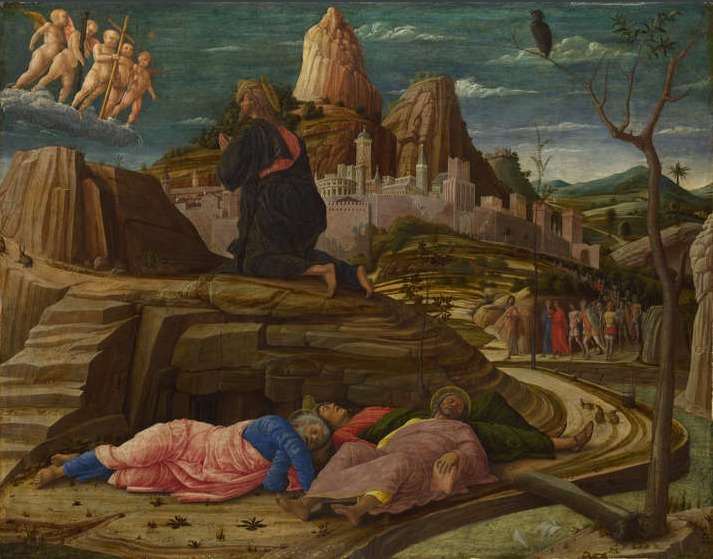
Andrea Mantegna Agony in the Garden. 1458-1460
Tempera on wood. 62,9 × 80
The National Gallery, London
Source: nationalgallery.org.uk 55
In the research literature, much has been said about the impact of creativity on the manner of Venetian Bellini Mantegna, however, influence was mutual. Bellini (especially Giovanni) learned the more complex and multifaceted slozhnorakursnye compositional schemes, and works by Mantegna purchased iridescence inherent in Venetian painting. And even with the passage of time, especially at the end of 1490's - early 1500's, more and more carried away by Mantegna play of colors and more attention will be given to small and decorative items, will remain the same thing: his admiration for ancient art, which arose, apparently, a master Skvarchone still be seen in figures formulation and cutting plastic forms and effort, particularly in the early period to create the illusion of to such an extent that its images appear bulky, protruding beyond the plane of the canvas and a soft, free flowing folds of the characters costumes, always dressed in the antique manner (most of his colleagues in the shop depicted in the gothic style clothing).
In 1459 Mantegna moved from Padua to the court of the Duke of Gonzaga in Mantua, became his court painter and is highly paid for their work. In addition, the Duke of Mantua was a well known lover of antiquity and the artist commissioned the care of their collections, which allowed Mantegna more fully immerse themselves in their favorite culture of ancient Greece and Rome.
One of the most important works: Mantegna made for Gonzaga, steel mural Camera degli Spozi which he graduated in 1474. Camera degli Spozi - a small square room with two small windows, the former initially bedroom Ludovico Gonzaga, and later served for honorable guests - like a front bedrooms of many major European palaces, was completely covered with frescoes: the ceiling was decorated with painting, imitating the air well and the sky, the walls were painted with scenes from the history of the Gonzaga dynasty.
 Andrea Mantegna Camera degli Spozi. Diffuser. 1465-1474 mural. The diameter of 270 Palazzo Ducale, Mantua, Italy Source: wga.hu | Andrea Mantegna Camera degli Spozi. Yard of the Duke of Gonzaga. Fragment of a fresco. 1465-1474 mural. 805 × 807 Palazzo Ducale, Mantua, Italy Source: wga.hu |
1488-1490 Mantegna years spent in Rome, working on an order of Pope Innocent VII - paintings Belvedere Chapel (not preserved), however, in addition to the papal frescoes, during this period he wrote a large number of easel paintings, many of which can be seen today in the largest museums in Europe.
However Mantegna due to its popularity and orders received more and more opportunities to continue to explore the ancient culture and the arts. By 1492 include a very interesting series of nine paintings under the title "The Triumph of Caesar," in which the author refers to the historical genre and consistently portrays all he knows about the ancient world - from military guns and architecture to the coins, medals, processions of dancers and musicians. By the end of 1490's he began to write and mythological themes.
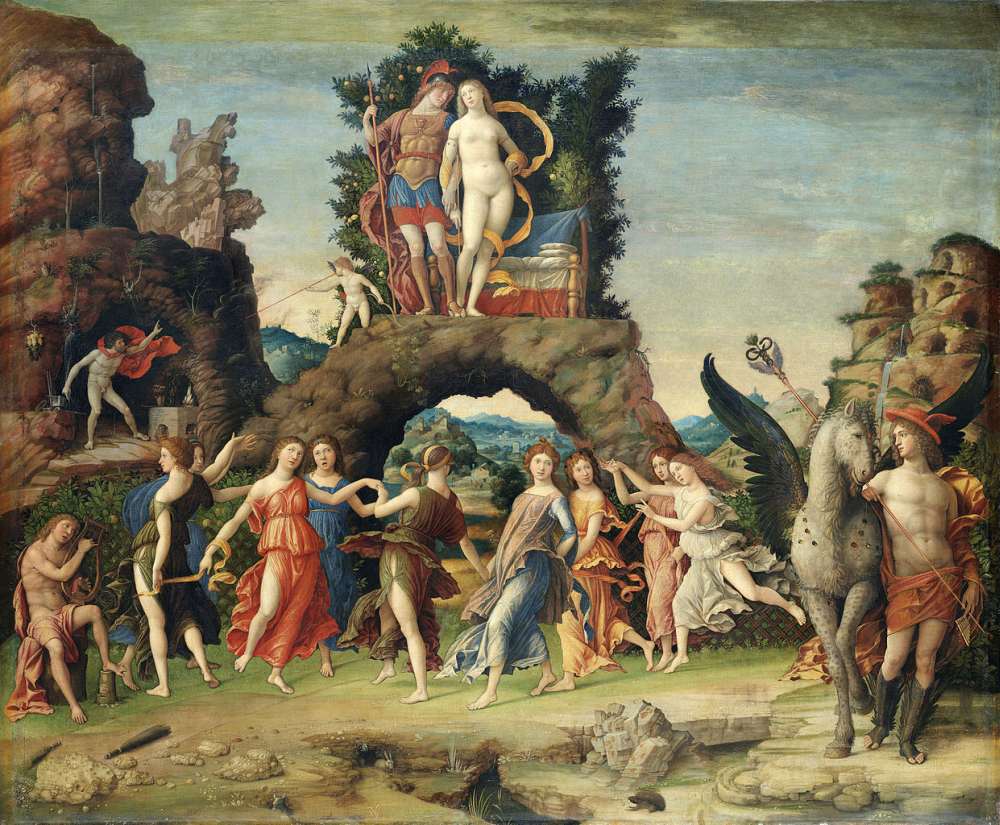 Andrea Mantegna Parnassus (Mars and Venus). 1497 Tempera on canvas. 159 × 192 Louvre, France Source: cartelen.louvre.fr |
most well-known, but however, the most unusual and mysterious of his paintings is considered to be the work of "Dead Christ". For a long time it was dated 1500 years, but now scientists from penmanship soft folds of fabric, a lot of work with the prospect of strokes and techniques to lean towards more early date - 1457. In the literature, one can also come across a dating app. 1480 - as the average date between these two assumptions.
 Andrea Mantegna Dead Christ. Approx. 1480 Tempera on canvas. 68 × 81 Pinacoteca di Brera, Milan Source: commons.wikimedia.org |
in challenging perspective the figure strikes and even introduces confusion as to its compositional structure and iconography. Once able to look away from in challenging perspective to the most accurate perspective reduction of the central figure of Christ, you find yourself wondering about the almost monochrome painting surface, that Christ is depicted with no more care than the bed on which he lay, and brought down by the most to the level of the subject, that the figures of Our Lady and St. John in its flatness and simplicity almost inseparable from the background. However, there are some in this picture mesmerizing immateriality (probably plays a role discrepancy size bed and a body on it), forcing to look into it again and again and feel like a witness and participant of biblical events.
fascinates and draws it today. A striking example - the use of this composition in the film by Andrei Zvyagintsev's "The Return».
| Still from the film" The Return ". Dir. A. Zvyagintsev 2003 Source: filmz.ru |
works by Mantegna consider it a great honor and good fortune to have in their collections of the Uffizi Gallery and other museums in Italy, the Louvre in Paris, the National Gallery of London, the New York Metropolitan Museum, etc. Unfortunately, in Russia it is not work, but at times they can be seen at shows.
On the art market every appearance of works by Mantegna (as well as his masters level) - a sensation and an event of global significance. From 1991 to 2013 in the auction catalog, they appeared only 43 times, and almost always in the graphics section. Painting is his incredibly rare in the market over the last 20 years easel (board, tempera) sold only 2 times, each time with record results.
40 times sold graphics (Draw and original), and in April of this year at a German auction was an attempt to sell a few sheets of grisaille (oil and tempera on paper). Given the rarity of such an occurrence in the market, there is nothing surprising in the fact that the percentage of works sold tends to 90.
record amount for the work of Mantegna was recorded January 23, 2003 during the bidding auction house Sotheby's in New York City. More than $ 25.5 million paid an unknown buyer for a small (39 × 42) undated tempera "Descent into Hell". According to estimates by artprice 2011, this result is in 9th place in the top ten most expensive on the open market of old masters, ahead of paintings by Rembrandt.
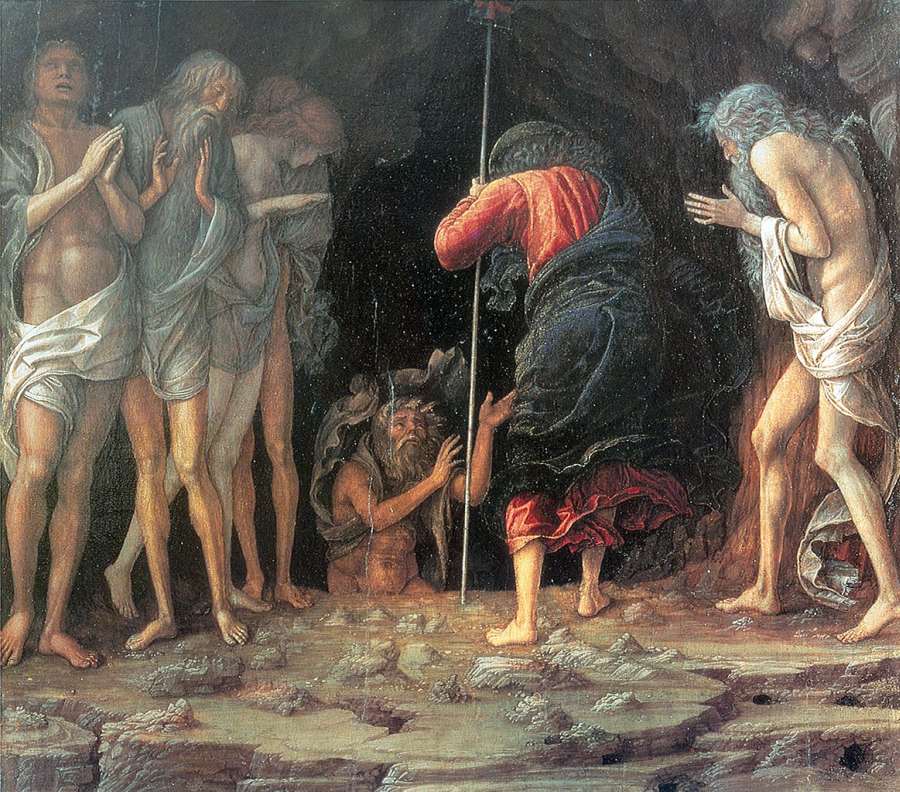 Andrea Mantegna The Descent into Hell board, tempera and gold. 39 × 42 Sotheby's. 23.01.2003. Lot 62 Estimate: 20 000 000-30 000 000 Result: 25.5 million dollars Source: commons.wikimedia.org |
in 2007 (shortly before the crisis) at the same Sotheby's, but in London, canvas "Madonna and Child" was sold for 240,500 pounds (nearly half a million dollars). In fairness it should be noted that, apparently, this work is undated (tempera on canvas. 47,6 × 36,8) refers to an earlier period of the artist and may not represent the artistic value of this as a "descent into hell" .
| Andrea Mantegna Madonna and Child Tempera on canvas. 47,6 × 36,8 Sotheby's. 05.12.2007. Lot 54 Estimate: 200 000-300 000 pounds Result: 240,000 pounds Source: sothebys.com | 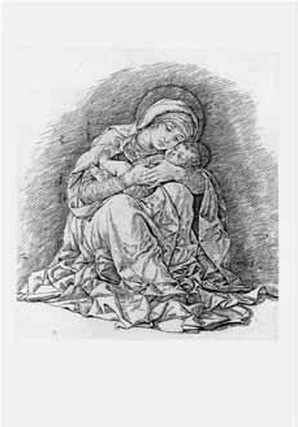 ANDREA Mantegna Madonna and Child metal engraving, drypoint Damien Libert SVV. 14.11.2002. Lot 17 Estimate: 18,500 euros Result: 60,000 euros Source: damienlibert.com |
record price at 60,000 euros for the graphics (Draw) was established way back in 2002 in France. That is the amount given per sheet "Madonna and Child", exceeding the estimate by more than three times.
Sale Mantegna's work today. Of course, this Draw graphics, but in the middle and lower price segments. Three sheets of it are not very rare series of "Bacchanal with a barrel of wine" (1490) were sold June 5, 2013 during the auction the auction house Bonhams at 2,125 pounds (while the estimate of 600-800 pounds). So for fans of the old Italian masters have the ability to replenish the collection of the works of the great Andrea Mantegna.
Maria Kuznetsova, AI
Sources:
- J. K. Argan . The history of Italian art. Moscow: Raduga, 2000.
- Giorgio Vasari . Lives of the most famous painters. M.: ABC-classic, 2004.
- Italian Renaissance Art. Ed. Rolf Toman. Konemann, 2001.
- artprice.com
- artinvestment.ru
Permanent link to:
https://artinvestment.ru/en/invest/artistofweek/20130716_mantegna.html
https://artinvestment.ru/invest/artistofweek/20130716_mantegna.html
© artinvestment.ru, 2024
Attention! All materials of the site and database of auction results ARTinvestment.RU, including illustrated reference information about the works sold at auctions, are intended for use exclusively for informational, scientific, educational and cultural purposes in accordance with Art. 1274 of the Civil Code. Use for commercial purposes or in violation of the rules established by the Civil Code of the Russian Federation is not allowed. ARTinvestment.RU is not responsible for the content of materials submitted by third parties. In case of violation of the rights of third parties, the site administration reserves the right to remove them from the site and from the database on the basis of an application from an authorized body.



